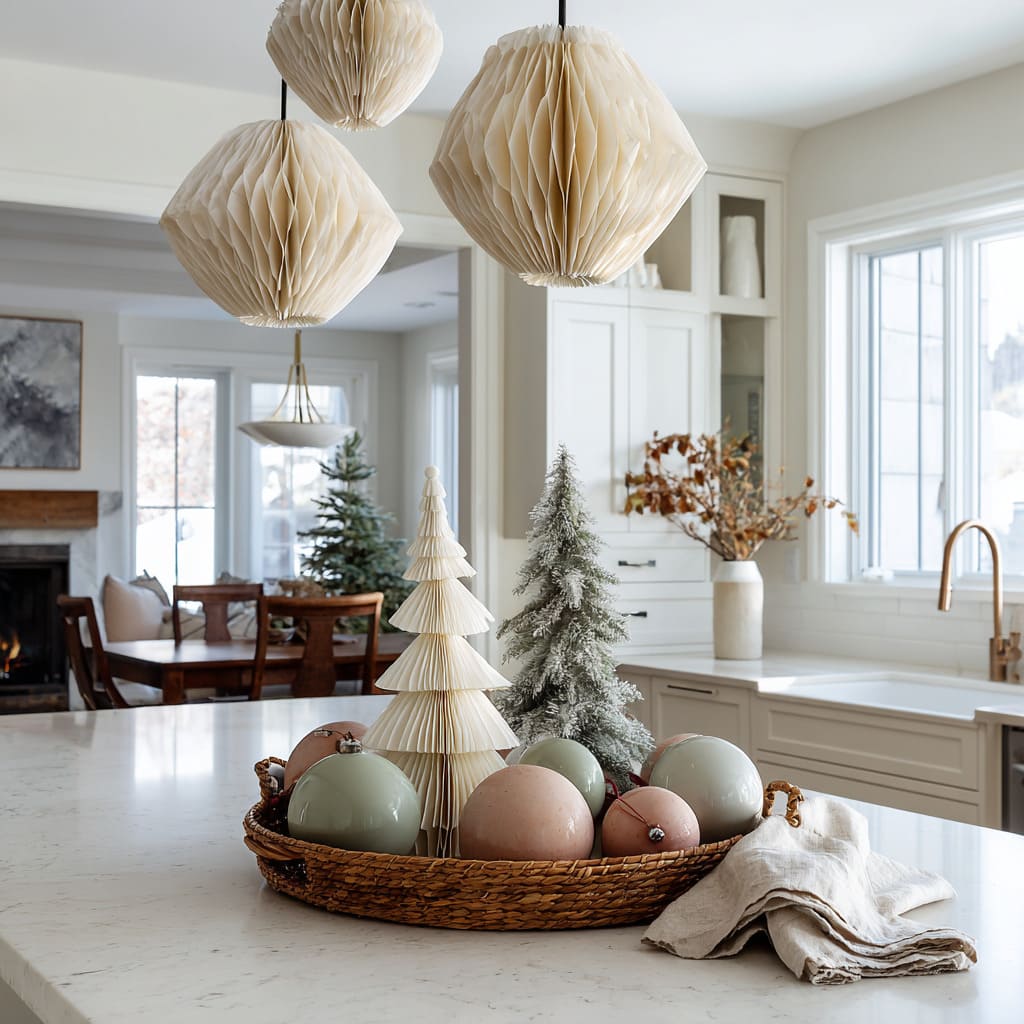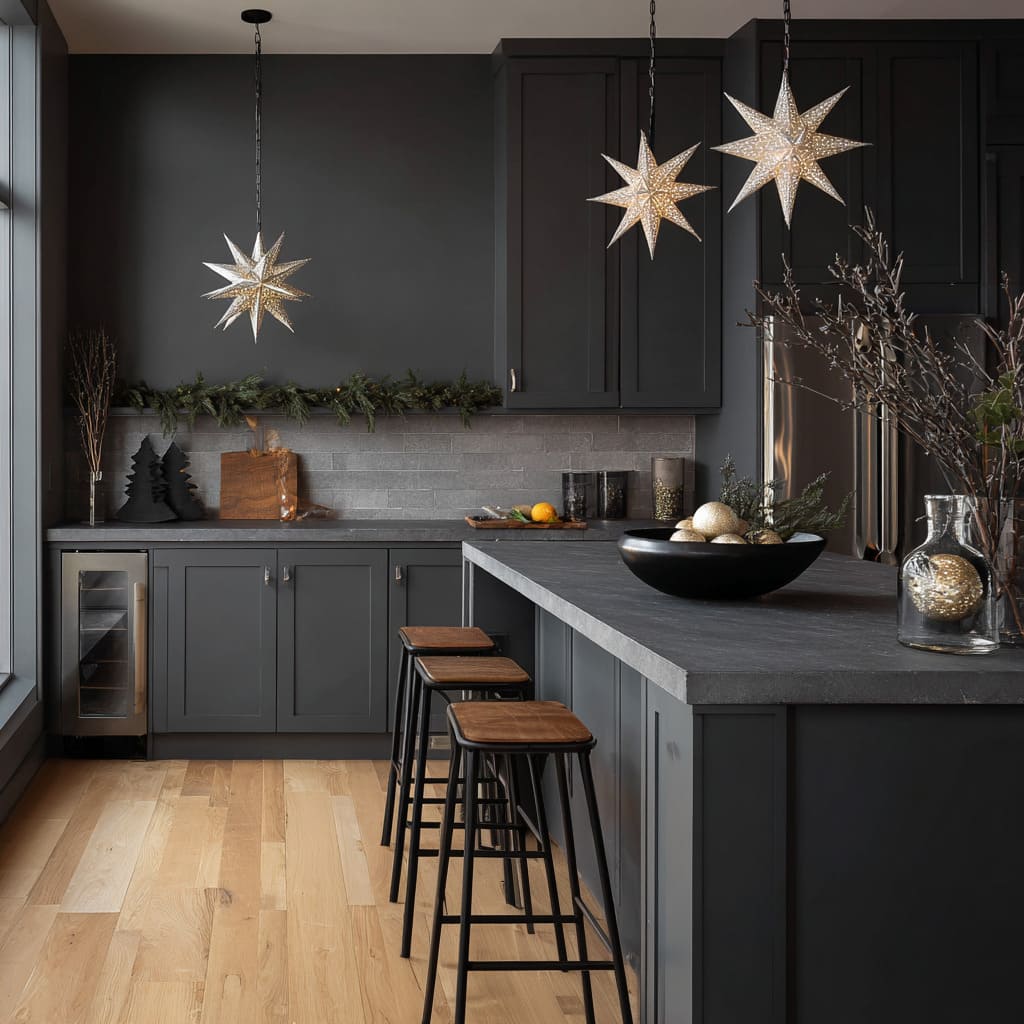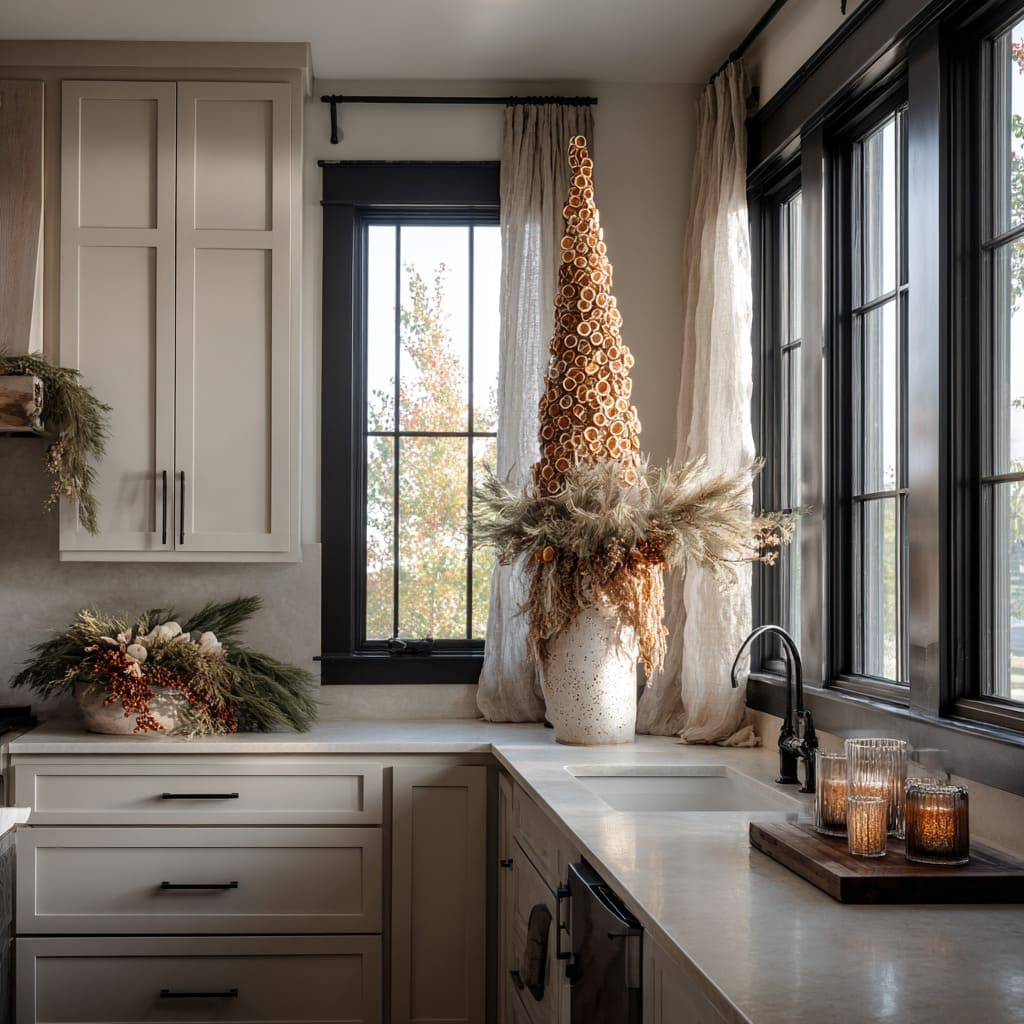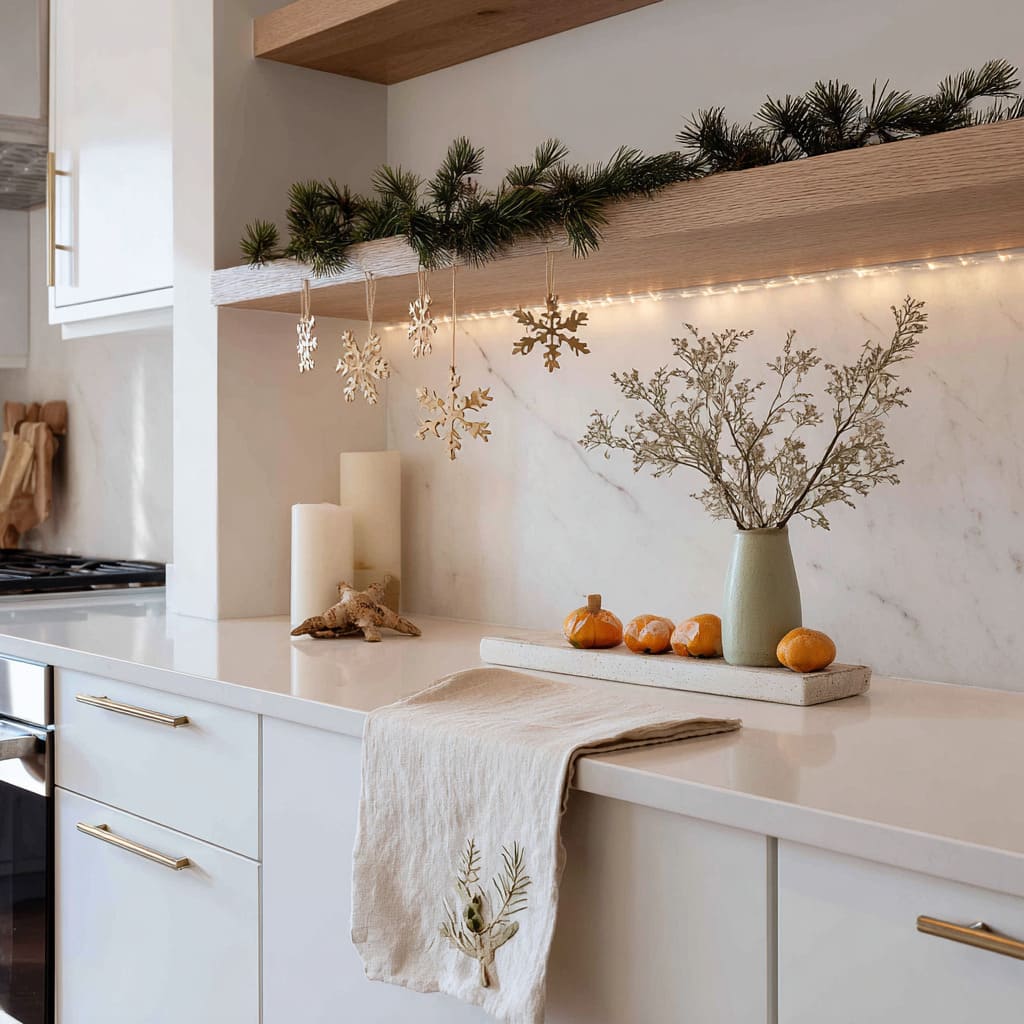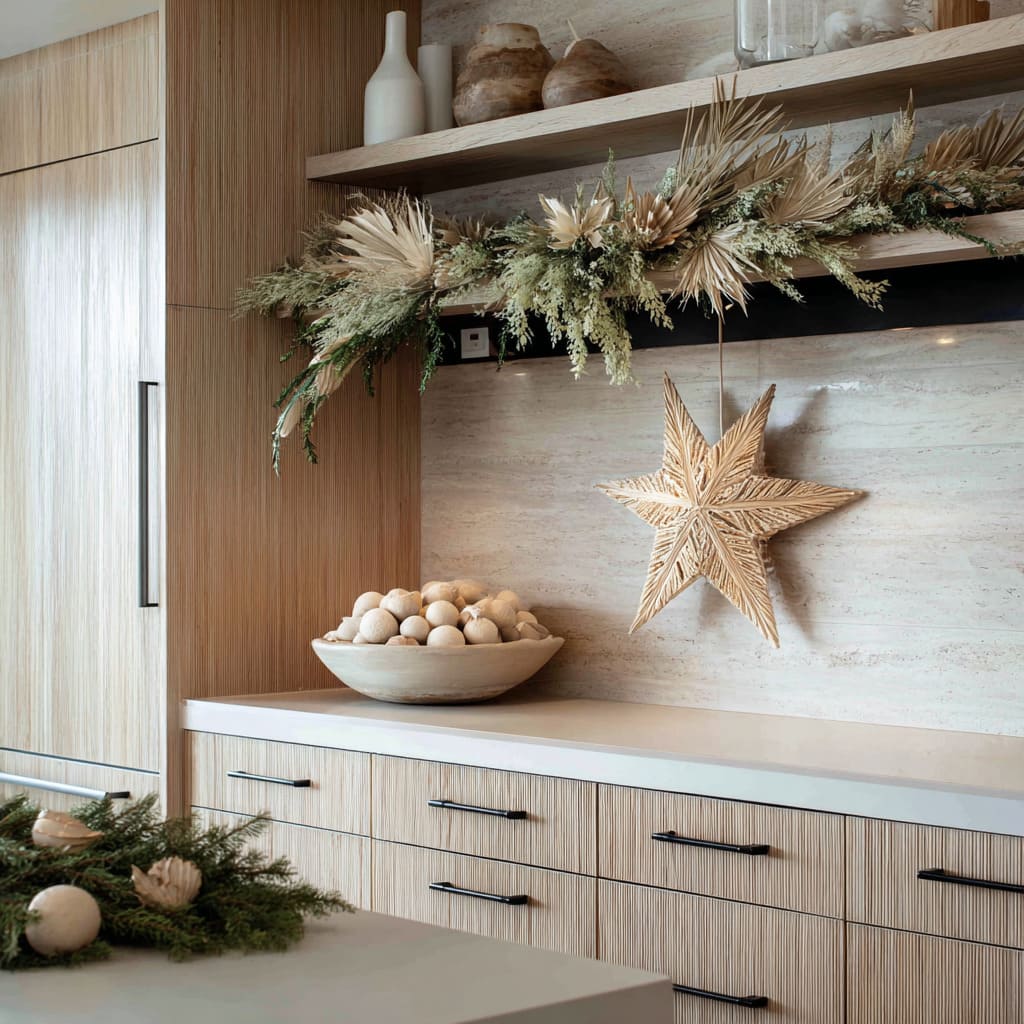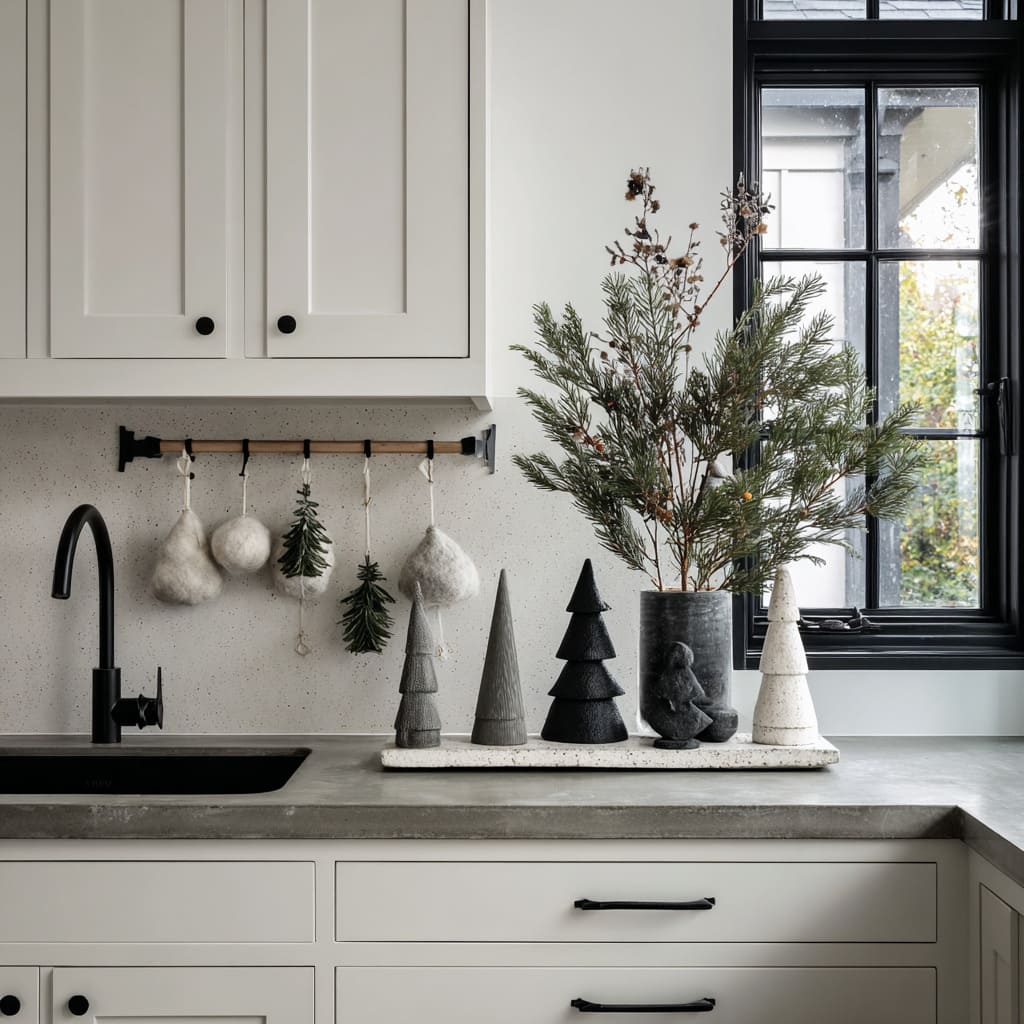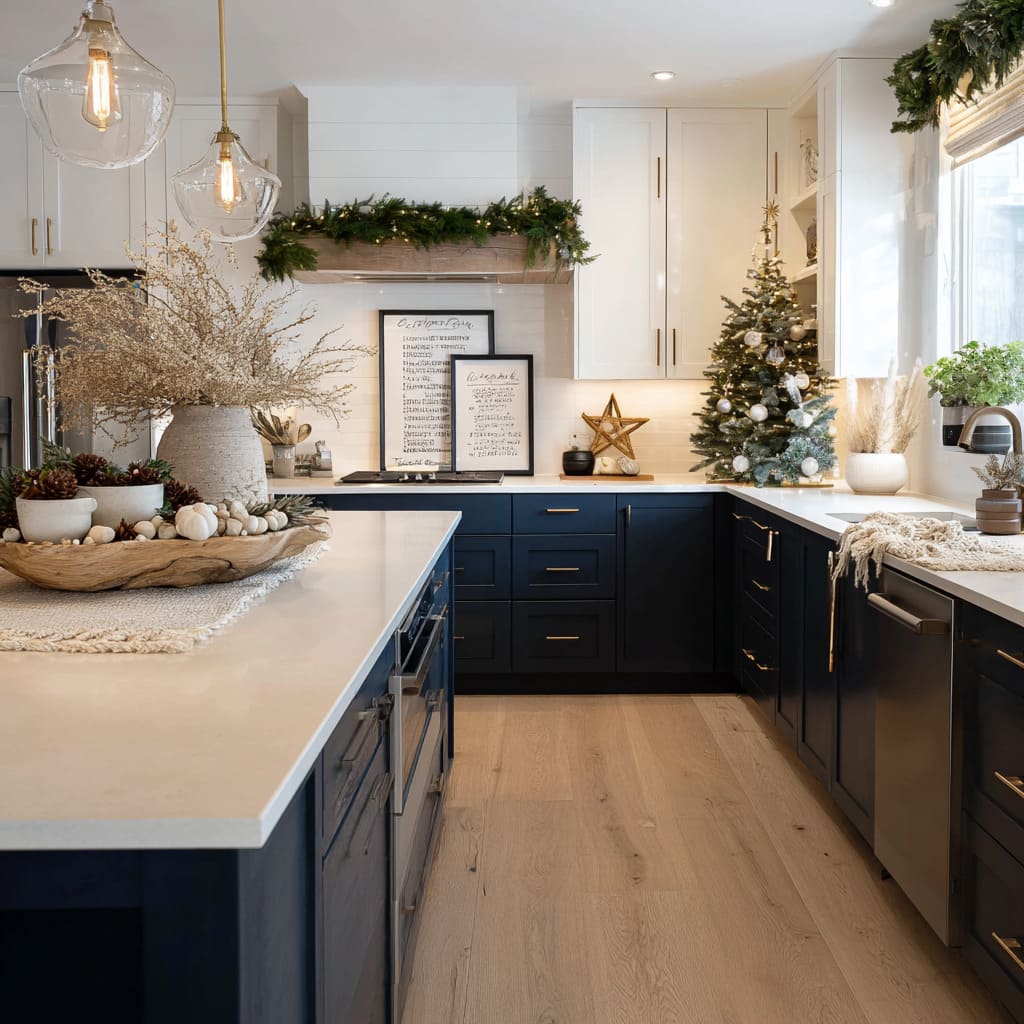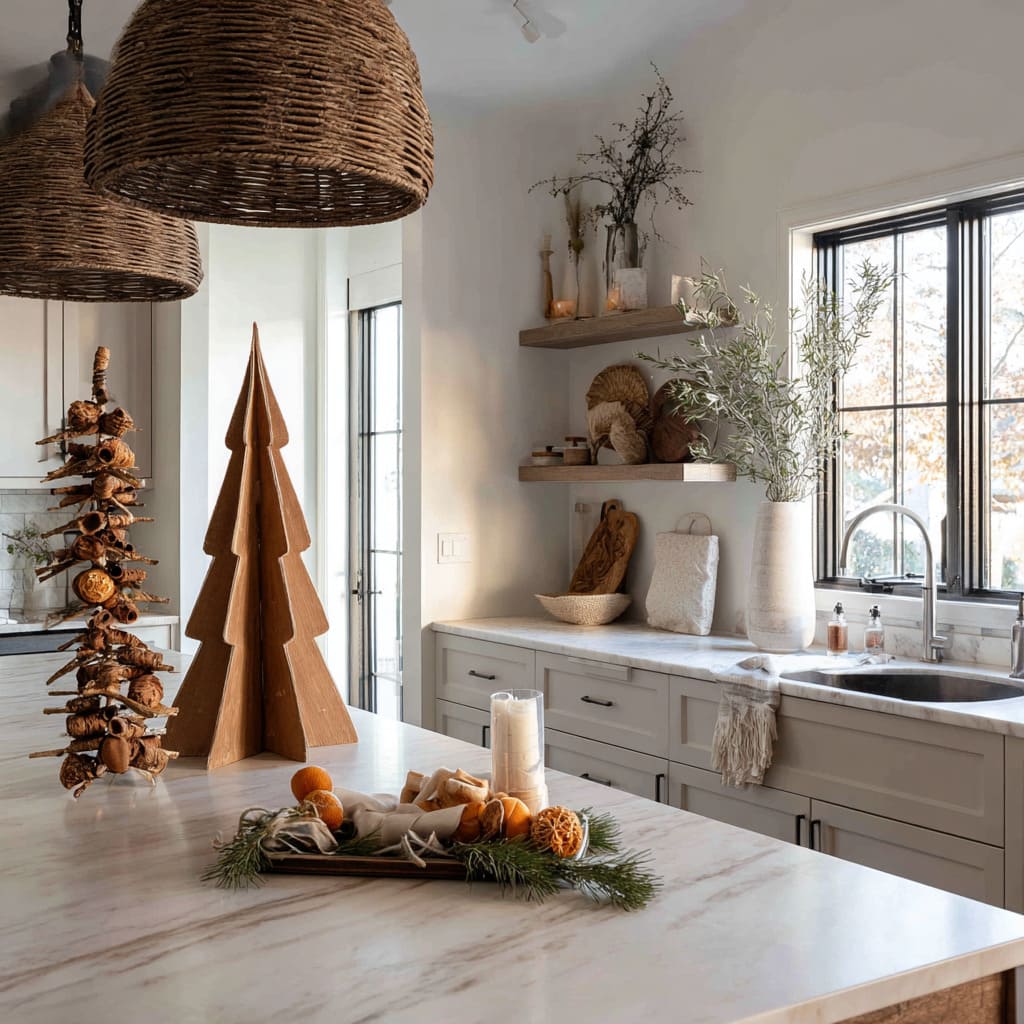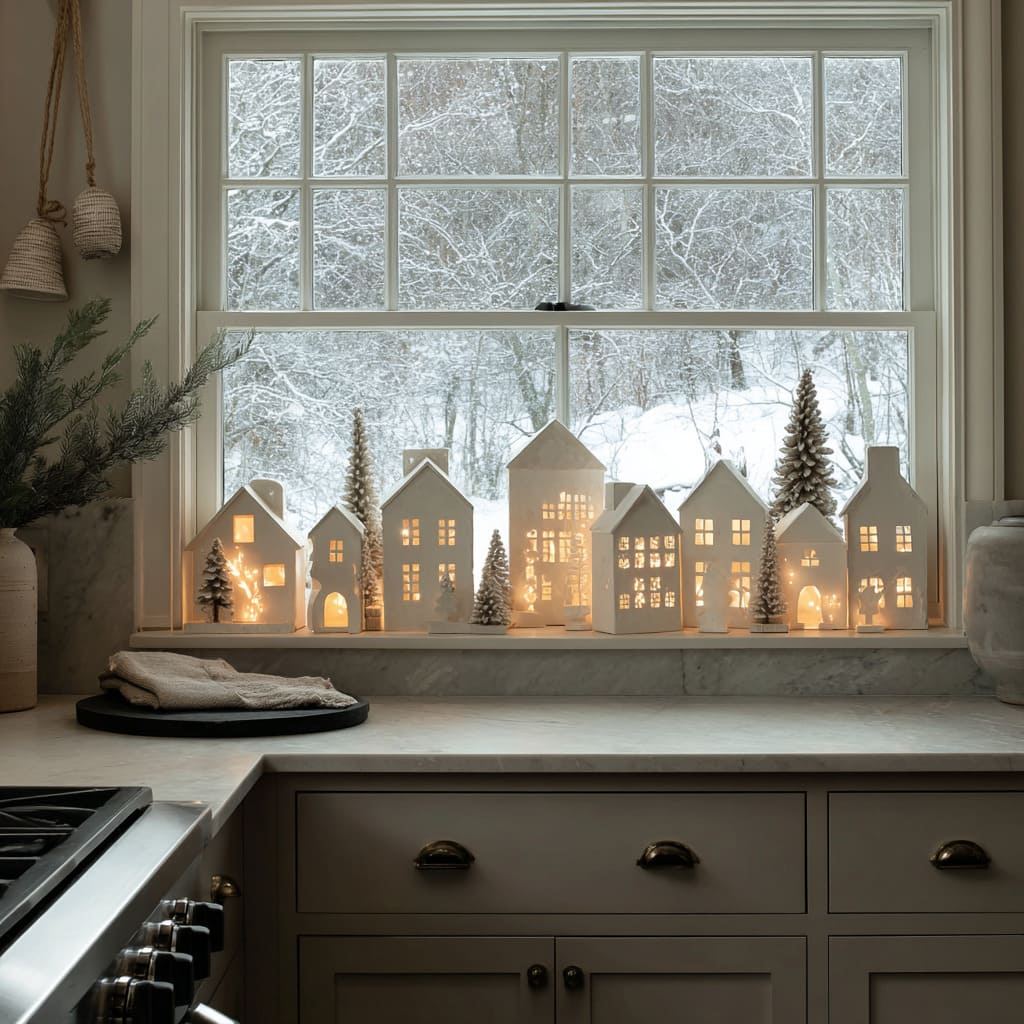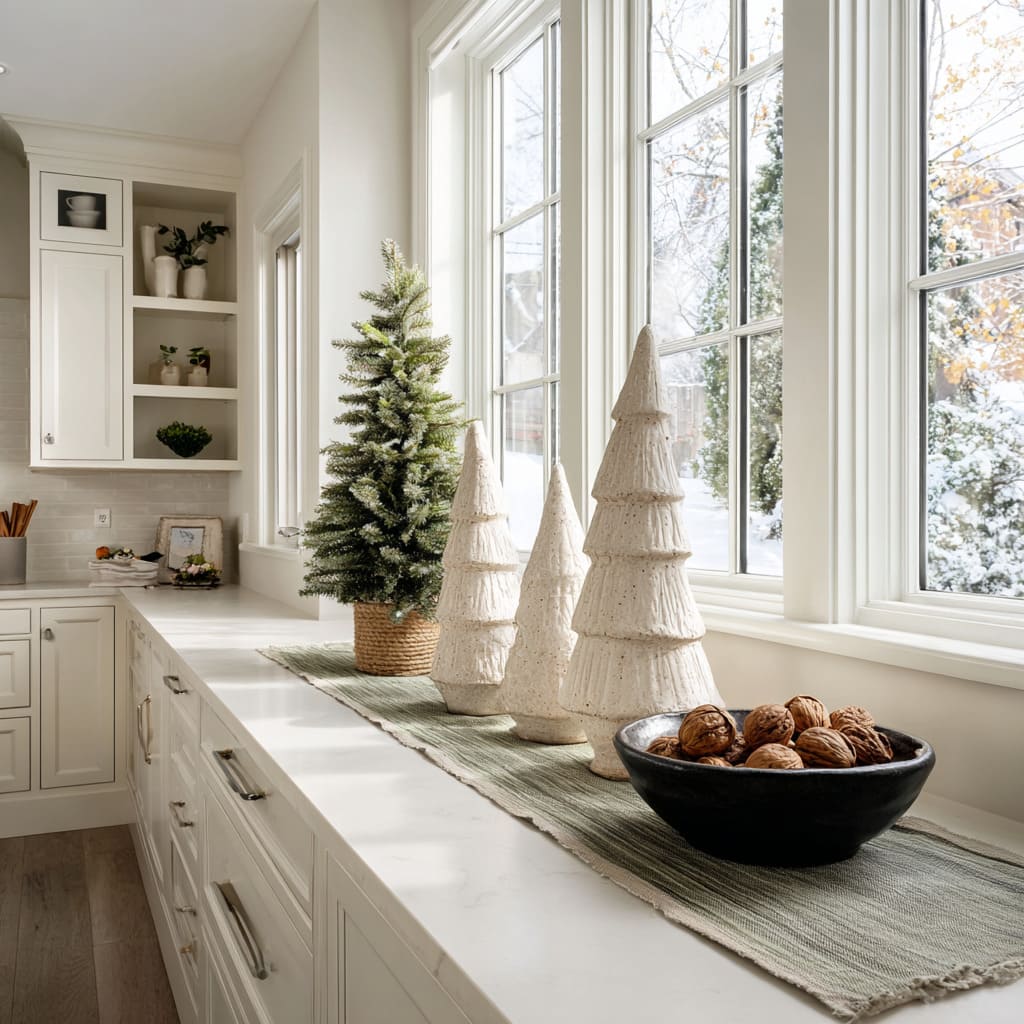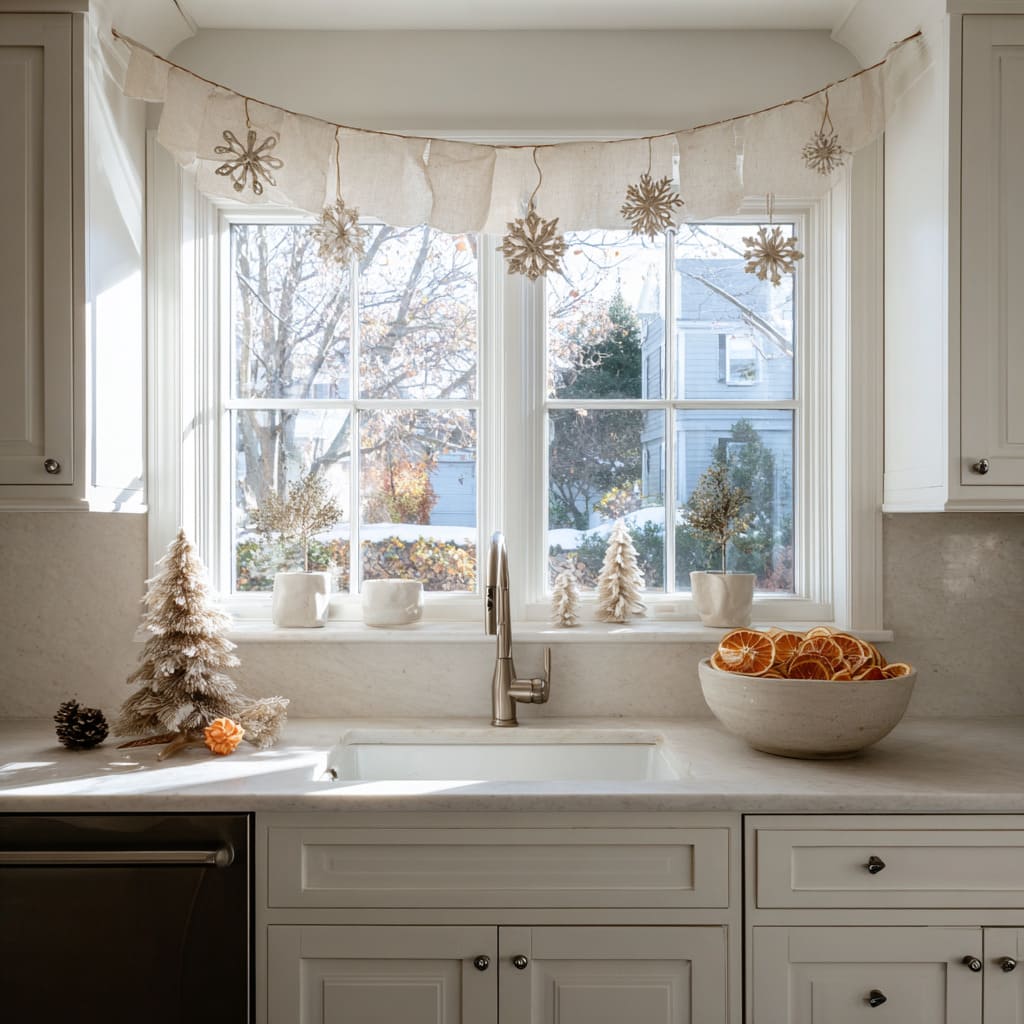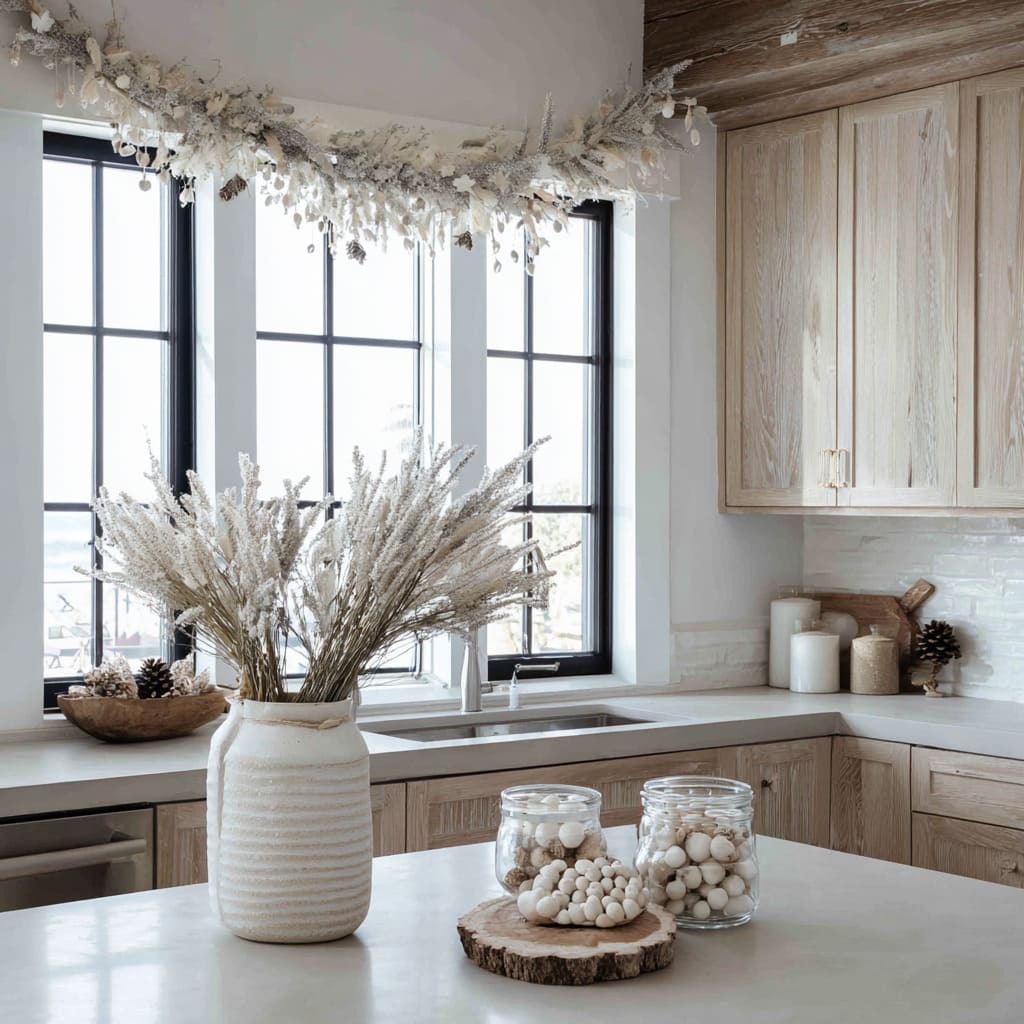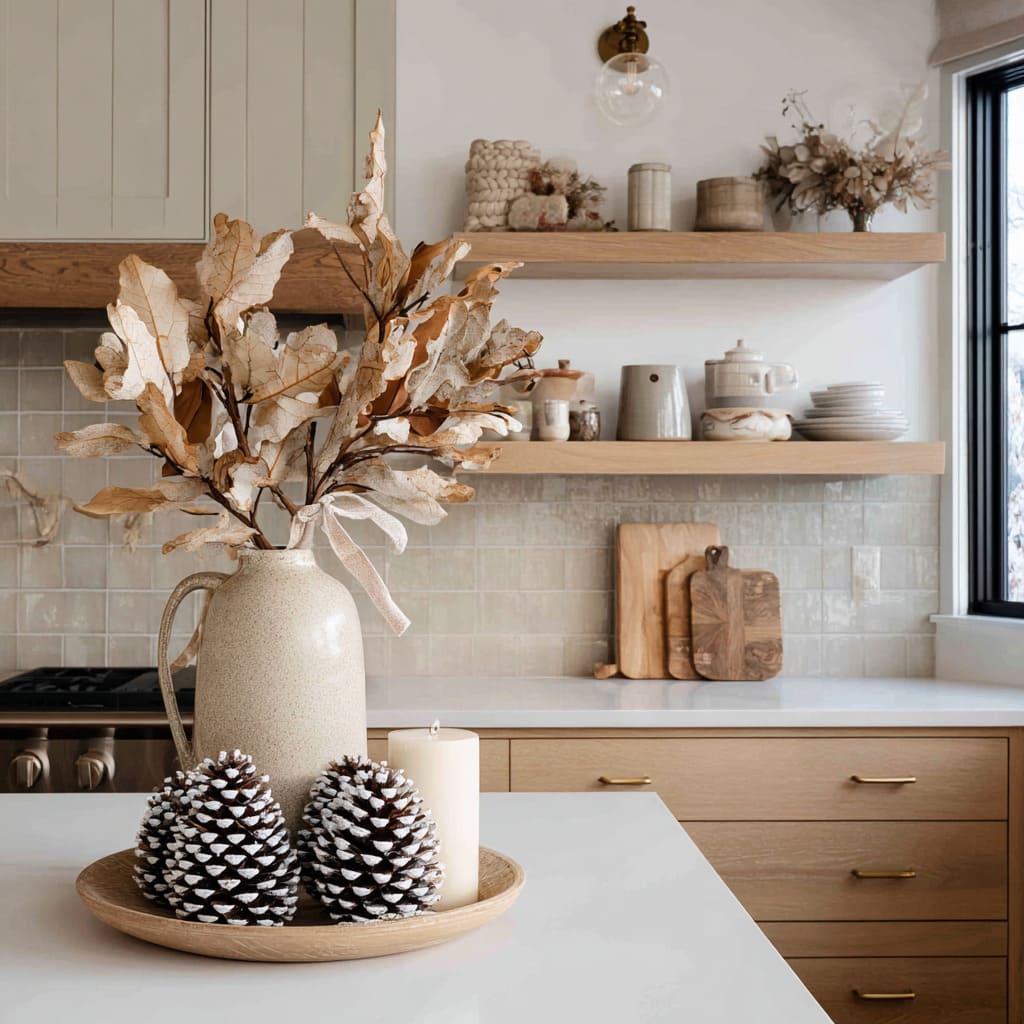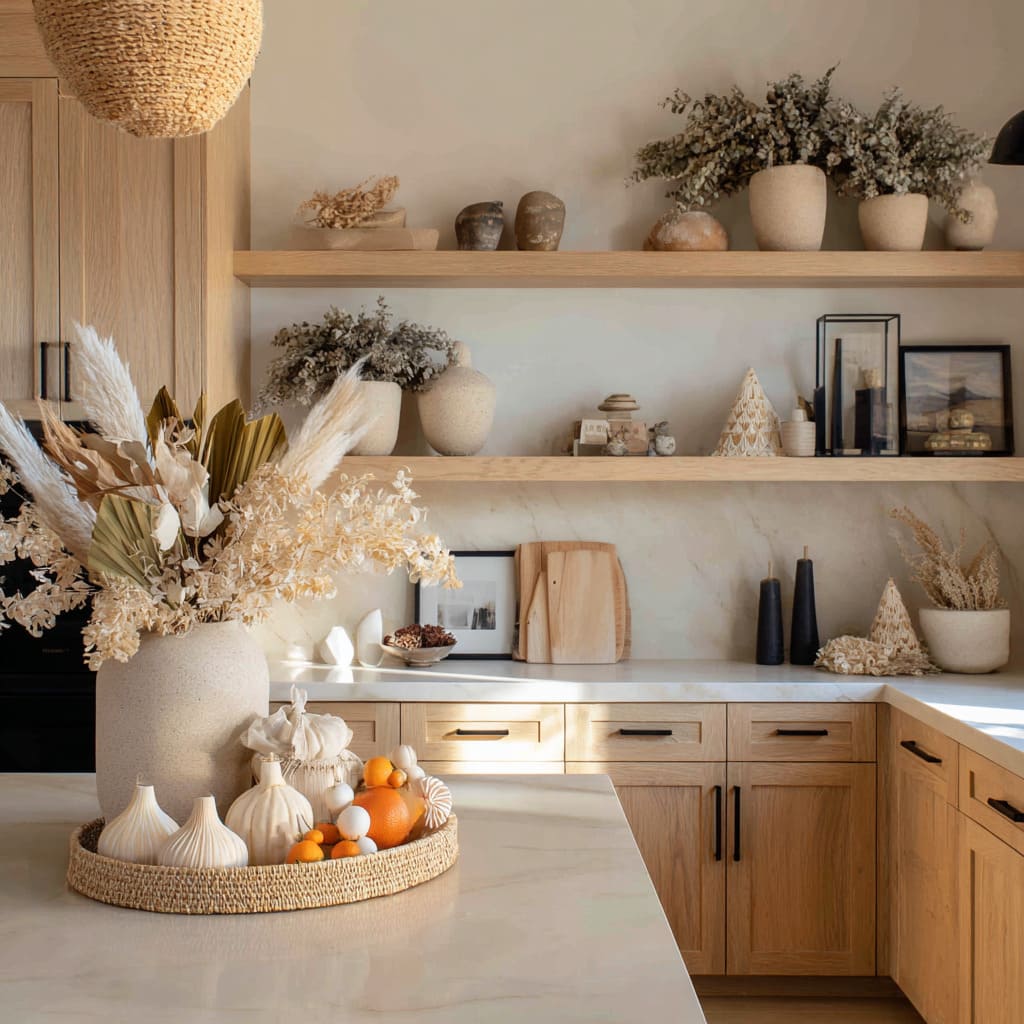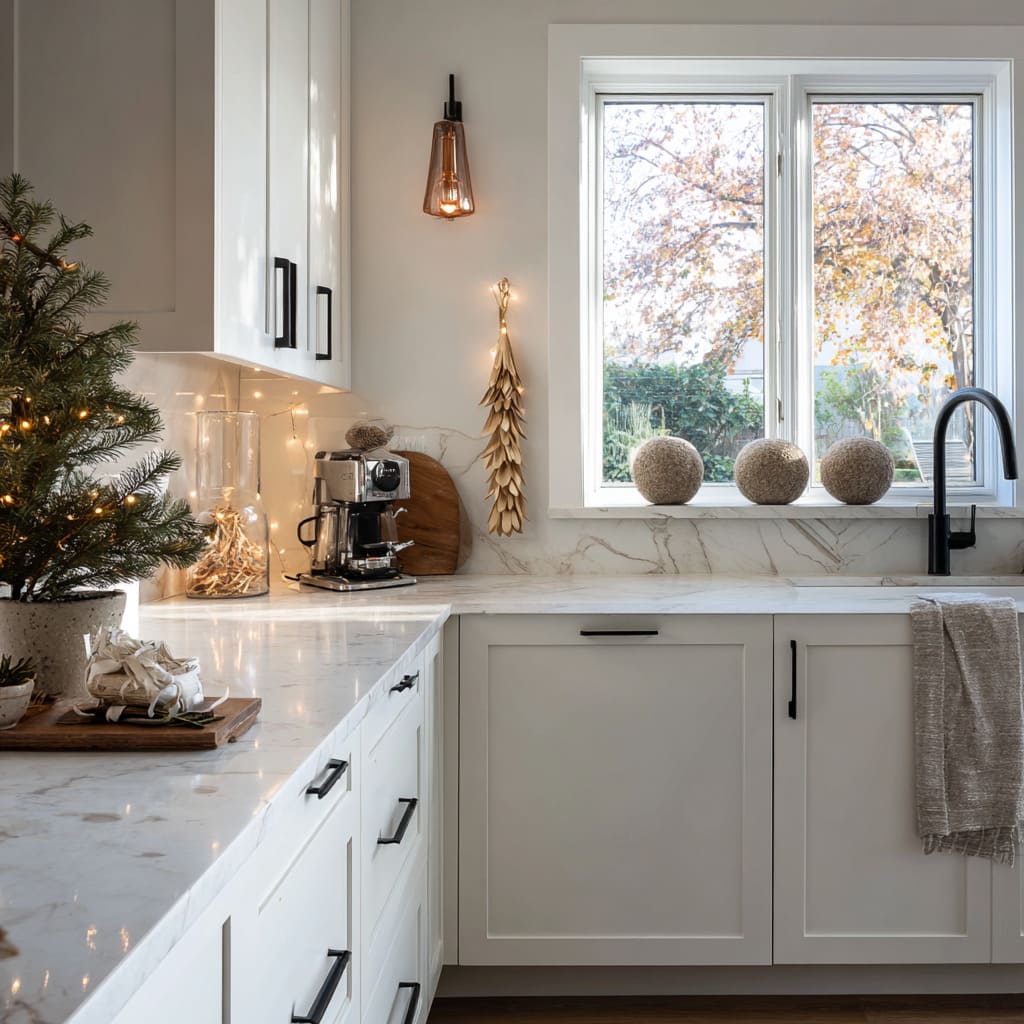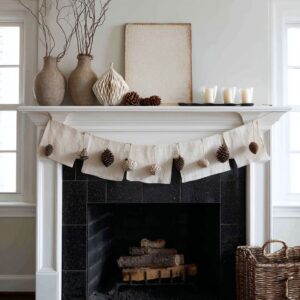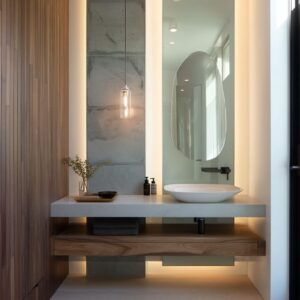Traditional Christmas decorating has taken a quieter turn in today’s kitchens. Instead of layering bold reds, shiny greens, and sparkle-heavy accents, the focus now moves to tone, shape, and material contrast.
This newer approach favors warm neutrals, raw textures, sculptural elements, and items that feel collected rather than themed.
The modern kitchen doesn’t pause for the season—it adapts. Everyday items like ceramic bowls, wood trays, and cutting boards are often part of the scene, styled alongside seasonal elements in a way that feels easy and real.
Decorations are no longer added as an afterthought—they’re worked into the flow of daily function.
Color gives way to surface. Matte finishes meet natural fibers.
Soft light replaces flash. The most effective choices feel connected to the space itself rather than layered on top of it.
Whether it’s a branch draped over a shelf, a bowl of clementines beside a pine garland, or a set of neutral-toned cones gathered on the counter, each piece earns its place through texture and presence.
This shift doesn’t erase the holiday feeling—it reshapes it. The result is a style that looks seasonal without leaning on symbols, a way to mark the moment while staying close to the pace and palette of modern kitchen living.
Tone and Texture as Guiding Stars
Modern kitchen Christmas decorating ideas often build their appeal not by using bold color, but by letting texture take the lead. The strongest scenes tend to quiet the palette—letting material contrast bring mood and rhythm into play.
A charcoal-toned cabinet surface gains softness when paired with pale oak stools. The grain of butcher block feels deeper when it sits beside polished marble or honed limestone.
Smooth quartz next to a roughly woven runner, or glossy tile bouncing daylight beside a cotton branch garland—these combinations give the space a sense of tension and calm at once.
In certain kitchen decorating ideas, the use of driftwood or aged ceramics adds a subtle break in finish, helping everything feel more layered without leaning on shine or glitter. The tone-on-tone effect keeps visual noise down, and instead lets weight, surface, and light bounce do the talking.
It’s a slow, grounded look where even the smallest difference in sheen—matte against slight gloss—can guide the mood.
Shapes as Visual Signals
A recurring trait across the most distinctive kitchen Christmas ideas is how form repeats itself at different scales—pulling the viewer’s eye across the room in soft, steady waves. A group of felt trees on a counter may echo a larger sculpted pine shape hanging above the shelves.
Overhead, a star-shaped light fixture may connect visually to a small metal ornament tucked between cutting boards. These echoes are rarely symmetrical, but they always feel purposeful.
By playing with size—large above, small below—and keeping to similar shapes, the composition gains quiet rhythm. Even groupings of three or five decor pieces create harmony without strict alignment, balancing the layout without calling attention to itself.
What happens, in effect, is that the space becomes easier to absorb all at once, with form creating a structure that holds everything together, even when color is muted. These moments of repeated form make the festive mood feel natural—not staged—by giving the eye a pathway that flows gently from corner to ceiling.
Blurring Function and Festivity
In many kitchen ideas with a seasonal setup, the most interesting details aren’t the obvious ones. What stands out is how everyday items—cutting boards, stacks of cookbooks, even a bowl of fresh dough—are blended into the seasonal layout without breaking flow.
The mix doesn’t feel arranged or decorative in the traditional sense. Instead, these elements do double duty.
A stack of light-colored books, for example, might serve as a subtle color block that ties visually into a strand of muted red beads or a nearby clay ornament. Wood trays, often used for prep or serving, become grounding points for soft trees or seasonal fruit.
The effect is quiet but layered.
These kitchen ideas don’t separate function from decoration; they let the rhythm of real life shape how the space looks during the holidays. The most successful kitchen cabinet Christmas decorations often grow directly out of this concept—relying on the flow of daily use, rather than pulling the kitchen out of its rhythm for the season.
Horizon Lines and Visual Rhythm
Horizontal alignment plays a key role. These lines aren’t loud, but they structure the scene.
Windowsills, open shelves, the edge of a tiled backsplash, even the top line of cabinetry—all form subtle guides that decoration builds upon. A garland stretched loosely across a window doesn’t just fill space; it bridges the inside with what’s beyond the glass, especially when the snow or tree branches outside echo the palette inside.
In other kitchens, the edge of the stove hood can become a natural place to anchor something like a thin evergreen swag, drawing a soft band between the contrast of upper and lower cabinets. What looks simple is often quietly precise—every ribbon, sprig, or garland sits along a visual track that stabilizes the space.
This method gives christmas decorations for a kitchen a structure to rest on, helping them feel grounded and aligned without relying on symmetry or heavy layering.
Organic Sculptural Gestures
A standout shift in modern kitchens styled for the holidays is the way natural elements are treated more like art than ornament. Driftwood placed above a counter doesn’t act as a shelf or a prop—it holds presence through shape, length, and how its surface texture catches light.
Citrus-slice cones, palm leaves, wheat bundles, or dried citrus rings take on a sculptural role, filling negative space with rhythm rather than color.
These objects often follow the movement found in branches or vines, creating vertical interruptions in spaces that are otherwise defined by strict horizontal lines. That tension between the straight edge of cabinetry and the curve of a dried branch adds quiet animation.
These elements don’t sparkle or shout, but they hold the eye. The most thoughtful christmas decorations ideas for kitchen spaces rely on this type of contrast: natural forms placed in sharp, clean environments, where even a single stem or palm frond can shift the tone from ordinary to seasonally grounded.
Holiday by Subtraction
In the most refined kitchen ideas, festivity often arrives through reduction—not addition. Rather than layering bright reds or shiny greens, the palette moves toward tones that feel rooted and open-ended.
A mix of white, sand, oat, and soft clay lays the groundwork, while black or charcoal accents give shape and weight. Instead of glitter, there’s the dry shimmer of frosted greenery, or the subtle sheen of ceramic glaze under soft window light.
This creates a look that belongs to the colder months without tying itself to a single holiday. A bowl of walnuts on a linen runner, a pine branch beside a stack of cookbooks—these hold meaning through placement and texture, not overt messaging.
These are ideas for decorating a kitchen for Christmas that can quietly carry through from early winter to the end of the season. This approach doesn’t dilute the holiday mood—it gives it space to breathe.
Breathing Room and Curated Clusters
In many modern kitchen designs dressed for the holidays, what’s left empty matters just as much as what’s on display. A wide counter with a single garland and a few oversized pinecones carries more visual strength than a densely packed layout.
The open space lets form take the lead—each object holds weight because there’s air around it.
Whether it’s a paper fan folded into a soft horizon line or a candle resting on a windowsill with falling snow beyond it, the layout feels thoughtful without being overly arranged. These gaps in decoration act like visual pauses, letting the eye rest and reset.
It’s a subtle but powerful move. What sets this approach apart is the way it avoids filling space out of habit.
Instead, a handful of objects—if well-chosen—can tell the entire seasonal story. Many christmas decorations ideas for kitchens benefit from this restraint, where fewer, larger gestures carry more warmth than rows of scattered items.
Echoes and Micro-Mirrors
Another detail shaping the atmosphere is how visual connections are built between materials, shapes, and finishes. A smoky glass pendant might seem like a lighting choice, but it also repeats the gray tone of the countertop below.
A strand of micro-lights tucked into greenery can subtly reflect the tone or shape of a metal fixture elsewhere in the room.
Carved ornaments on a shelf might mimic the fluting found on cabinet drawers or chair backs. These are quiet echoes, not obvious matches—and that’s what makes them effective.
They work in the background, tying one part of the space to another through soft alignment.
This approach doesn’t call attention to itself, but it builds unity across the whole room. What begins as a light fixture, a ribbon, or a ceramic bowl becomes part of a broader visual system that helps everything sit together with ease.
Conclusion: A Quiet Shift Toward Seasonal Atmosphere
The most compelling holiday kitchens today avoid the expected. Instead of centering on color-coded themes or preset styles, they focus on how things feel and how they sit together.
Material contrast leads—matte beside gloss, soft fabric near polished stone—offering warmth without needing much else. Lighting softens edges, and shadows do as much work as ornaments.
What stands out is the subtle repetition of shapes: cone trees in different sizes, stars scattered in various forms, rounded objects echoing one another across shelves and counters. These gentle patterns guide the eye without demanding it.
Function isn’t removed—it’s integrated. Cutting boards, cookbooks, and trays become part of the story, lending familiarity to the layout.
Lines already present in the kitchen—shelves, ledges, cabinetry seams—give structure to the festive setup without needing extra support.
Natural objects, sculpted materials, and handmade pieces take the place of glossy mass-produced decor. What remains feels more thoughtful than themed—a setup that blends seamlessly into the season without calling attention to its own purpose.
It’s a holiday look that holds up over time, one that feels collected, lived-in, and built to stay beyond the final days of winter.

